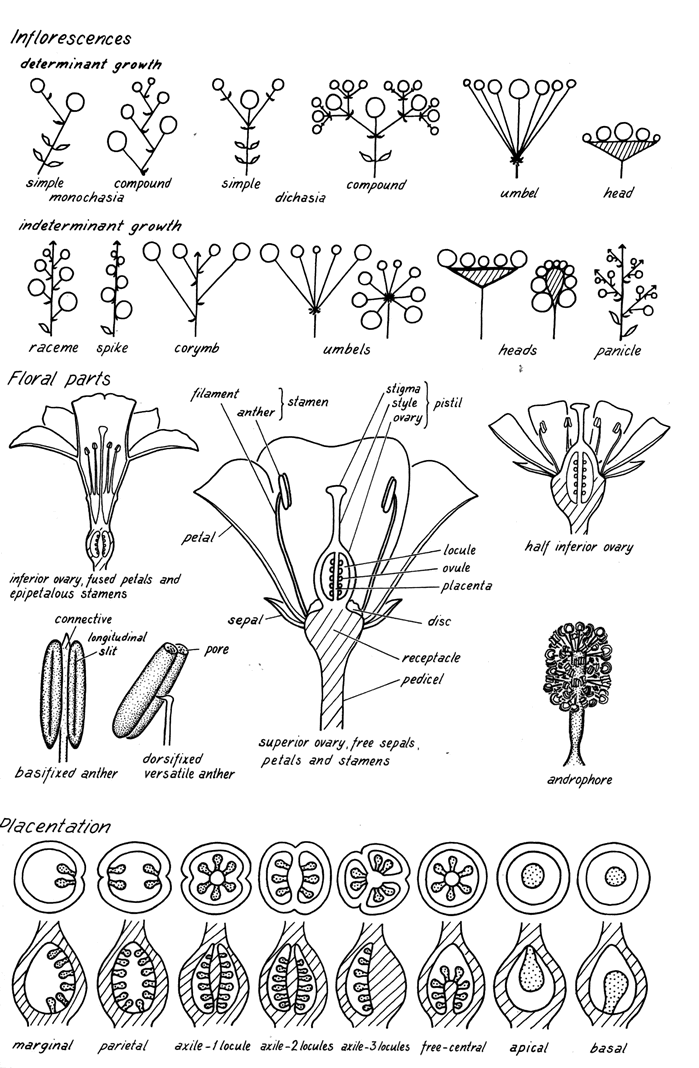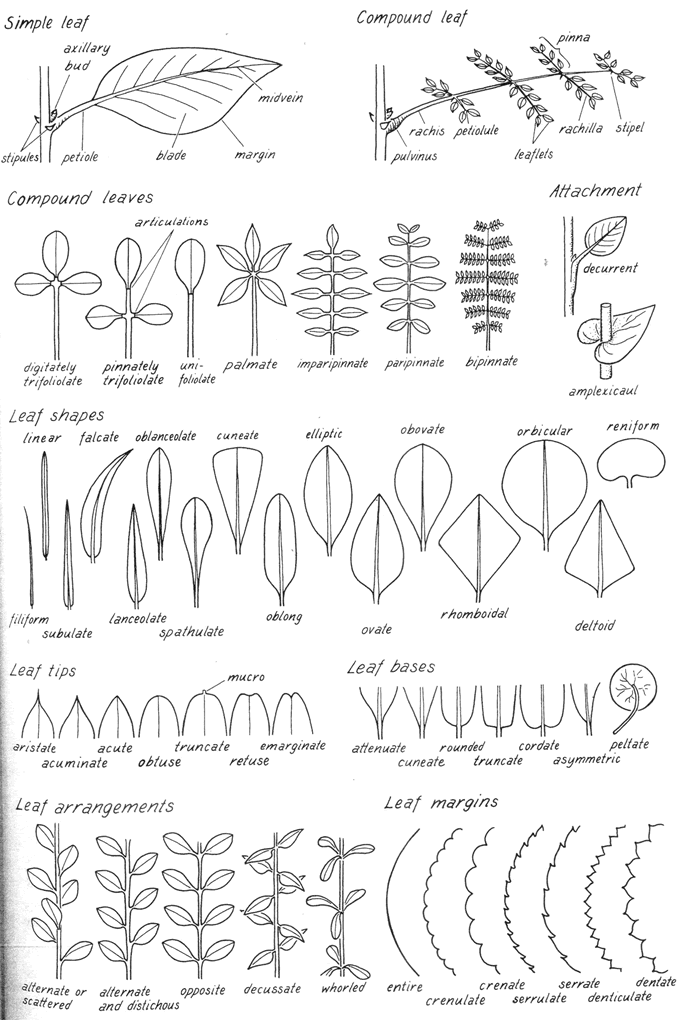Plant
photos
a change of format
Glossary of plant termsLast updated 14 October 2004 |
|
Illustrated Glossary


Taken from Dunlop CR, Leach GJ and Cowie ID Flora of the Darwin Region Vol 2
Collecting and keying out plants
Specimens for identification ideally consist of a plant with leaves, flowers and fruit preferably still attached to the twig, with supplementary notes on features of the plant not visible on a dried specimen, e.g. flower colour. To help keep specimens in optimal condition they need to be kept fresh or pressed and dried. Newspaper is ideal for drying specimens in, and they can be pressed in a folder, book (phone books are good) or plant press. Make sure that your specimen is laid out evenly and not pressed while bunched up. Some features should be looked for in the field and noted if you are collecting a specimen of the plant to key out later.
First check the growth habit and height of the plant - is it a vine, shrub or tree. Many woody vines start life
with a shrubby habit. What colour are the flowers and or fruit, how are they arranged, what are their dimensions? Check for any sap or latex that may be present when you break a leaf off. Note the leaf arrangement on the plant - are the leaves opposite or alternate, is the leaf simple or is it compound, etc? Look for spines on the stems or trunk, as well as the colour of the bark and if it is rough, smooth or flaky. Also do the leaves have any scent when crushed? All information should be noted, for the more characters noted, the easier it is to correctly identify the plant.
Always try to collect both young growth and old growth, as the young growth on many plants is often hairy, while the old growth can be consistently glabrous.
Do not forget locality, was it from near Alice Springs or in your backyard in Katherine. When starting out it is almost essential to have a good glossary or botanical dictionary at hand to understand the terminology used in plant identification keys.
Flowers and Fruits
These are the reproductive parts of plants and are generally the main structures used in plant identification. The number and arrangement of petals, stamens, stigmas, and ovaries, size of fruits, number of seeds, ovaries and structure are important in plant identification.
Compound Leaves
A compound leaf consists of (one) two to many distinct leaflets forming a compound structure with a regular arrangement of these leaflets. A compound leaf is borne on a stem and a small bud (axillary bud) can often be seen in the junction where the compound leaf joins the stem. Leaflets on a compound leaf never have axillary buds.
Stipules
Stipules are accessory structures that protect buds. They are found in certain plant families, e.g. RUBIACEAE, EUPHORBIACEAE. They occur where the base of the leaf petiole joins the stem, and are a reliable tool in plant identification. Usually they are small and in pairs, one on each side of the petiole base. They are usually more easily seen on new growth and are easier to see in the growing season. In the dry season when there is little growth they can be difficult to find on some species, but by using a 10 X magnification hand lens on the newer growth, the stipules or stipular scars should be visible. Stipules will usually persist for only a short time on most species but can be persistent and large on some species, Nauclea orientalis being a good example.
Glands
Glands of various types may occur on leaves and occasionally other places and are of great value in recognising certain families and genera. Oil glands are very small, translucent dots seen by holding the leaf up towards a strong light and examining it with a hand lens. The glands will be visible as small pinpricks with the light being visible through them, and they are usually numerous. Their presence is often confirmed by an aromatic scent when the leaf is crushed. Vesicular glands are normally raised and coloured, like very small droplets on the leaf surface. They are often numerous on the surface of the leaf, Mallotus nesophilus being a good example. They can be clear to red or black in colour. Extra floral nectaries or glandular outgrowths may weep a sugary substance that attracts ants or other insects. They are usually found at the base of the blade, near the junction with the petiole on simple leaves, but on compound leaves can be seen anywhere on the rachis. Often they can resemble a split in the mid-vein such as in the Beach Hibiscus, Hibiscus tiliaceus, or small outgrowths resembling stalks or domed glands. The presence of any of these structures is usually an extremely reliable identification tool. Some species of plants can have very small glandular outgrowths in places other than as stated above, such as scattered over the leaves.
Domatia
Domatia are small distinct cavities, swellings, or hair-like tufts found in the angles between the midrib of the leaf and the main lateral veins. They are usually easier to find on the under-surface of the leaf. It is thought that they give protection to predatory mites who in turn protect the leaves from various herbivorous mites. Domatia are very well developed on Dysoxylum acutangulum and are common on the leaves of many Terminalia spp.
Juvenile Leaves
Some plants show a marked variation between the leaves on the mature plants and on juvenile plants. One particular variation type on juvenile trees is holly-like leaves with spines on the margins. Other seedlings and juveniles have variations that can occur between the seedling stages and the adult plant.
Rather than just copy someone else glossary here a few links to other internet-based glossary lists
Centre for Plant Biodiversity Research Glossary Site
An Introduction to Collecting Plants